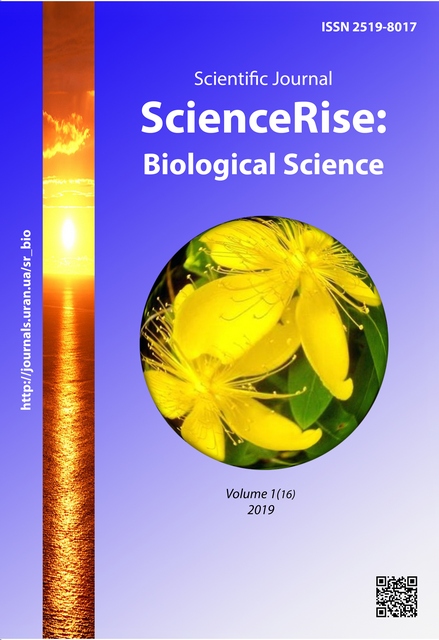Influence of pre-sowing seed treatments with biologically active substances on spring wheat rhizosphere microbiocenosis
DOI:
https://doi.org/10.15587/2519-8025.2019.158380Keywords:
Triticum aestivum, wheat, microbiocenocis, microorganisms, catalase, nanoparticles, nitrogen-fixers, actinomycetes, micromycetesAbstract
Aim of research. To evaluate changes in the spring wheat rhizosphere microbiocenosis at the pre-sowing treatment by citrates of biogenic metals, created based on nanotechnologies and inoculation of the consortium of root microorganisms in soil at the effect of these arrangements on the enzymatic activity of leaf tissues and productivity of wheat plants.
Methods. Microbiological methods – inoculation on solid nutritive mediums for determining the content of main groups of soil microorganisms in the rhizosphere of plants; biochemical – for determining the activity of antioxidant enzymes of catalase and peroxidase; biometric – for determining the mass of 1000 seeds and seed productivity on experimental areas; statistical.
Results of research. Field experiments of crops of spring wheat Pecheryanka demonstrate that at the pre-sowing treatment of seeds by 1%-solutions of biologically active substances in the content of composite fields of citrates of nanoparticles of Ag+Cu and Co+Cu+Zn+Fe+Mn+Mo+Mg (Avatar-1) and ions I-Se and introduction of the consortium of soil-useful microorganisms (biopreparation BP Extrakon), there were observed changes of ratios of main microbial groups in the composition of soil microbiocenocis: aerobic nitrogen-fixers, actinomycetes, fungal microflora, oligotrophic bacteria, that in some way correlated with the seed productivity.
Conclusions. 1. It has been established, that the ratio of microbial groups, especially the percent of groups of aerobic nitrogen-fixers increased in the wheat rhizosphere relating to the control in the following succession – in the earing phase: BP Extrakon˃Extrakon+I-Se, and in the milk ripeness phase – in the following succession: BP Extrakon+I-Se˃BP Extrakon˃Avatar-1˃Ag-Cu. Actinomycetes prevailed on the variant with the pre-sowing treatment by I-Se, and the fungal microflora – in the milk ripeness phase.
2. The activity of catalase ad peroxidase in leaf tissues at the pre-sowing treatment by biologically active substances was lower than in the control, except the variant of the pre-sowing treatment by citrates of nanoparticles of Ag-Cu, where the catalase activity a bit grew – by 7.9%.
3. It has been revealed, that indicators of the seed productivity improved most essentially at inoculation of the consortium of root microorganisms in soil, and also at the treatment that favored the increase of aerobic nitrogen-fixers in the soil rhizosphere, thus the seed productivity increased on the variants in the succession: BP Extrakon˃BP Extrakon+I-Se˃Avatar-1˃Ag+Cu, decreasing at the variant with the treatment by I-Se
References
- Kertész, Á. (2009). The global problem of land degradation and desertification. Hungarian Geographical Bulletin, 58 (1), 19–31.
- Grinchenko, T. O., Maklyuk, O. I., Zhuravlyova, I. M. (2012). The influence of thrichoderminum on the functional & structural peculiarities and biochemical activity of microbiocenosis structure of typical chernozem soils in conditions of heavy metal contamination.. Zbìrnik Naukovih Pracʹ HNPU imeni G. S. Skovorodi. Biology and Valeology, 14, 149–157.
- Sahu, N., Vasu, D., Sahu, A., Lal, N., Singh, S. K. (2017). Strength of Microbes in Nutrient Cycling: A Key to Soil Health. Agriculturally Important Microbes for Sustainable Agriculture, 69–86. doi: http://doi.org/10.1007/978-981-10-5589-8_4
- Sekhon, B. S. (2014). Nanotechnology in agri-food production: an overview. Nanotechnol Sci Appl, 7, 31–53. doi: http://doi.org/10.2147/nsa.s39406
- Sasse, J., Martinoia, E., Northen, T. (2018). Feed Your Friends: Do Plant Exudates Shape the Root Microbiome? Trends in Plant Science, 23 (1), 25–41. doi: http://doi.org/10.1016/j.tplants.2017.09.003
- Lebeis, S. L., Paredes, S. H., Lundberg, D. S., Breakfield, N., Gehring, J., McDonald, M. et. al. (2015). Salicylic acid modulates colonization of the root microbiome by specific bacterial taxa. Science, 349 (6250), 860–864. doi: http://doi.org/10.1126/science.aaa8764
- Duhan, J. S., Kumar, R., Kumar, N., Kaur, P., Nehra, K., Duhan, S. (2017). Nanotechnology: The new perspective in precision agriculture. Biotechnology Reports, 15, 11–23. doi: http://doi.org/10.1016/j.btre.2017.03.002
- Liu, R., Lal, R. (2015). Potentials of engineered nanoparticles as fertilizers for increasing agronomic productions. Science of The Total Environment, 514, 131–139. doi: http://doi.org/10.1016/j.scitotenv.2015.01.104
- Taran, N., Gonchar, O. M., Lopatko, K. G., Batsmanova, L. M., Patyka, M. V., Volkogon, M. V. (2014). The effect of colloidal solution of molybdenum nanoparticles on the microbial composition in rhizosphere of Cicer arietinum L. Nanoscale Research Letters, 9 (1), 289. doi: http://doi.org/10.1186/1556-276x-9-289
- Huliaieva, H., Tokovenko, I., Maksin, V., Kaplunenko, V., Kalinichenko, A. (2018). Effect of Nanoaquacitrates on Physiological Parameters of Fodder Galega Infected with Phytoplasma. Ecological Chemistry and Engineering S, 25 (1), 153–168. doi: http://doi.org/10.1515/eces-2018-0011
- Volkohon, V. V., Nadkernychna, O. V., Tokmakova, O. V., Melnychuk, T. M., Chaikovska, L. O., Nadkernychnyi, S. P. et. al.; Volkohon, V. V. (Ed.) (2012). Eksperymentalna gruntova mikrobiolohiia. Kyiv: Agricult. science, 464.
- Ho, A., Lonardo, D. P. D., Bodelier, P. L. E. (2017). Revisiting life strategy concepts in environmental microbial ecology. FEMS Microbiology Ecology, 93 (3). doi: http://doi.org/10.1093/femsec/fix006
- Anwar, S., Ali, B., Sajid, I. (2016). Screening of Rhizospheric Actinomycetes for Various In-vitro and In-vivo Plant Growth Promoting (PGP) Traits and for Agroactive Compounds. Frontiers in Microbiology, 7 (1334), 1–11. doi: http://doi.org/10.3389/fmicb.2016.01334
Downloads
Published
How to Cite
Issue
Section
License
Copyright (c) 2019 Hanna Huliaieva

This work is licensed under a Creative Commons Attribution 4.0 International License.
Our journal abides by the Creative Commons CC BY copyright rights and permissions for open access journals.
Authors, who are published in this journal, agree to the following conditions:
1. The authors reserve the right to authorship of the work and pass the first publication right of this work to the journal under the terms of a Creative Commons CC BY, which allows others to freely distribute the published research with the obligatory reference to the authors of the original work and the first publication of the work in this journal.
2. The authors have the right to conclude separate supplement agreements that relate to non-exclusive work distribution in the form in which it has been published by the journal (for example, to upload the work to the online storage of the journal or publish it as part of a monograph), provided that the reference to the first publication of the work in this journal is included.









